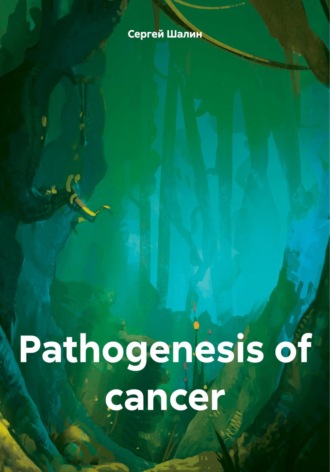
Сергей Алексеевич Шалин
Pathogenesis of cancer
ONCOGENESIS
The basis for the growth and development of oncogenesis is a malignant stem cell, and the basis for the “generation” of a malignant stem cell is the return of a tissue Monocyte, which has genotypic and epigenetic changes, to the embryonic state during mitosis, a differentiation block at the pluripotent or unipotent level and transformation. Monocyte – with a diameter of 16–18 microns, various morphological variations in the nature and intensity of coloring of the nucleus and cytoplasm. The kernels may approach round, bean-shaped shapes. The cytoplasm is grayish or pale blue in color and may contain numerous dust-like azurophilic granules. Differentiation of Monoblast into Monocyte occurs in the red bone marrow within 5 days. A monocyte stays in the bone marrow for an average of 3 days, then divides and, without forming a bone marrow reserve, enters the peripheral blood. In the blood, the Monocyte is the largest blood cell, here it matures, the nucleus becomes from round, first bean-shaped, then clawed, and the chromatin structure changes. Various levels of monocyte differentiation were found in peripheral blood, with more mature monocytes predominating in healthy people. In the blood, monocytes are distributed into parietal and circulating pools, exchanging with each other, the quantitative ratios of which may vary. In humans, the circulating pool of Monocytes is normally 18x10 to the 6th degree cells/kg body weight, and the marginal pool, which currently does not take part in the circulation, adjacent to the inner wall of the microvessel, is 3.5 times larger (63x10 to the 6th degree of cells/ kg body weight). In general, the total pool of peripheral blood monocytes constitutes from 1 to 10% of all leukocytes (80–600 x 109/l). Monocytes circulate in the blood from 36 to 104 hours (1.5 – 4.5 days) and then leave it according to a stochastic principle, interacting with specialized adhesion molecules on endothelial cells. Monocyte migration from the vascular bed to the focus of chronic inflammation occurs through areas of the microcirculatory bed with the second type of endothelium – these are postcapillaries and venules. Once in the focus of chronic inflammation, monocytes migrate. Cell migration is a process of passive displacement of cells or active movement of cellular complexes and isolated cells, caused by complex selective interactions of cellular receptors on the membranes of migrating cells and their microenvironment. Genotypic changes in the Monocyte can occur at different stages of hematopoiesis and the higher, according to the hematopoietic scheme, the greater potency the malignant stem cell will have. Therefore, it is important to know not only what genotypic changes in the nuclear DNA of the Monocyte arose, but also at what level of hematopoiesis they arose, i.e. Not only the nature of genotypic changes (spectrum of disturbances) of nuclear DNA is important, but also the level of genotypic changes (class according to the hematopoiesis scheme). For the “germination” of a malignant stem cell in solid tumors, the most likely levels of potency are:
1. Class II – pluripotent progenitor cell of the ancestor of myelopoiesis, common to 4 lineages (CFU-GEMMeg) with subsequent development in the direction of the Monocytic lineage.
2. Class III – unipotent progenitor cell of the monocytes (CFU-M). It must be emphasized that genotypic changes in nuclear DNA occur according to a recessive trait, therefore these changes do not manifest themselves in any way in the red bone marrow.
During the process of differentiation, genotypic changes are laid down in the genetic apparatus of the future Monocyte, which morphologically will not differ from a normal bone marrow cell. The acquisition of genotypic changes in nuclear DNA for a Monocyte is not decisive in the possibility of transformation into a malignant stem cell, because it can divide, mature, differentiate, transform into cells of the microenvironment, and transform into a Macrophage. And although irreversible genotypic changes are an absolute necessity for transformation into a malignant stem cell, this is completely insufficient. Genotypic changes in the DNA of the Monocyte nucleus will wait patiently until optimal conditions arise for their manifestation, and then the “nascent” descendants – malignant stem cells – will dominate the host organism.
For the “birth” of a malignant stem cell, subsequent growth and development of the malignant process, “super conditions” are required, creating an isolated state of the progenitor cell from the influence of the body. These conditions can be called a “pre-tumor” bed in pathologically altered local tissues against the background of pre-tumor diseases of the macroorganism. A “pretumor” bed can be an isolated microcavity, the formation of which during chronic inflammation is a natural process. However, it is not at all necessary that the formed isolated microcavity will become the place where the “birth” of a malignant stem cell will occur. Formation of an isolated microcavity: during the process of inflammation, small blood clots and dead tissue are reabsorbed. Large tissue defects resulting from fibrinous-necrotic inflammation are replaced by scar tissue. Small defects that occur between cells within the stroma first become lumens and then turn into microcavities. In response to tissue damage and under the influence of pathogenetic inflammatory factors, pluripotent poorly differentiated connective tissue cells, called “peripheral blood fibrocytes” or fibroblast-like cells, migrate from the bloodstream. Their immunophenotypic characteristics, combined with the ability to give rise to representatives of fibroplastic cell differential, suggest that they are multipotent mesenchymal stromal cells (MMSCs), constantly circulating in the blood in small quantities. It is these fibroblast-like cells that participate in the formation of the insulating shell of the microcavity, which acts as a “graveyard” for dead cells. Due to chemotaxis, a certain number of Monocytes enter an isolated microcavity, because not all of them are subsequently transformed into a malignant stem cell, but the transformation process never occurs from single cells. Once in an isolated microcavity, the Monocyte finds itself surrounded by an aggressive oxygen-free environment. He develops structural changes in the cell membrane and chemical changes in the cytoplasm – epigenetic changes. A tissue monocyte appears, which has genotypic and epigenetic changes – this is the potential precursor cell of the primary malignant stem cell of solid tumors. Such a Monocyte remains outwardly normal as long as it is in interphase, but as soon as it begins Mitosis, all changes will become obvious and manifest themselves. It is known that each Monocyte in tissues turns into an organ- and tissue-specific Macrophage during the process of transformation. Transformation is a series of cell divisions during which its phenotypic changes occur sequentially under the influence of the microenvironment. A monocyte, having genotypic and epigenetic changes, attempts to transform into a Macrophage (macrophage blast, promacrophage, tissue macrophage) and begins the process of mitosis, during which a return to the embryonic state occurs. However, after mitosis, the level of genotypic changes appears, as a result of which a block of differentiation of daughter cells occurs and transformation, during which the nature of genotypic changes in nuclear DNA appears. As a result, an unstable active system is “born” – a malignant stem cell, which has retained many of the basic abilities and capabilities of the mother cell – the tissue Monocyte, which has not completely left the embryonic state and acquires new abilities of its new life: the possibility of uncontrolled division, autonomous regulation, immortality of the population, etc. . A malignant stem cell is a proliferating somatic cell that has a certain level of potency, which corresponds to the level at which genotypic changes occurred in the bone marrow cell during hematopoiesis:
1. If genotypic changes in a bone marrow cell occurred at the level of a pluripotent progenitor cell of the ancestor of myelopoiesis with subsequent development into a monocytic lineage (class II), then the tissue monocyte is transformed into a pluripotent malignant stem cell with pronounced phenotypic heterogeneity and the possibility of the appearance of a “chimera” cell. with multiple differentiation.
2. If genotypic changes in the bone marrow cell occurred at the level of the unipotent progenitor cell of the ancestor of Monocytes (class III), then the tissue Monocyte is transformed into a unipotent malignant stem cell with minimal phenotypic heterogeneity. The “nascent” malignant stem cell, due to proliferation, creates a clone of malignant cells, which are the trigger, regulator and activator of the growth and development of the malignant process.
Thus, the following Monocytes and different groups of cells derived from Monocytes are possible in the human body:
1. The main group is normal Monocytes, which arose from the bone marrow cell and continued on their way into the bloodstream, and then entered the tissues and turned into macrophages.
2. The group of future cancer cells are Monocytes that received genotypic changes in their DNA in the germinal zone, penetrated into the blood, and then into an isolated microcavity in the infected tissue, where they were exposed to the environment. They eventually turned into cancer cells. In the future, contacts are possible between former Monocytes that have turned into Macrophages and former Monocytes that have turned into cancer cells. Most likely, these contacts will not be harmful to cancer cells, because They have the same basis and therefore there is no point in “fighting” among themselves.
3. The group with genotypic changes are Monocytes that received genotypic changes in their DNA in the germinal zone, but did not change phenotypically, although they changed some of their properties. Ultimately, in tissues they turned into macrophages and their derivatives.



